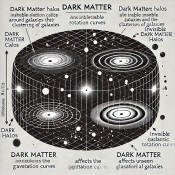Electronics & Technology
- See Full List of AI Topics -
 The concept of dark matter has become one of the most significant and perplexing
components of modern astrophysics and cosmology, representing the unseen matter
that makes up a substantial portion of the universe's mass. The origins of the dark
matter hypothesis date back to the early 20th century. In 1933, the Swiss astrophysicist
Fritz Zwicky observed the Coma galaxy cluster and calculated its mass using both
its luminous matter and the velocities of its galaxies. Zwicky found that the
visible matter was insufficient to account for the gravitational forces holding
the cluster together. He called this unseen mass "dunkle Materie," or dark matter. Although
his observations were groundbreaking, they did not receive widespread acceptance
at the time due to limitations in instrumentation and prevailing theories. The concept of dark matter has become one of the most significant and perplexing
components of modern astrophysics and cosmology, representing the unseen matter
that makes up a substantial portion of the universe's mass. The origins of the dark
matter hypothesis date back to the early 20th century. In 1933, the Swiss astrophysicist
Fritz Zwicky observed the Coma galaxy cluster and calculated its mass using both
its luminous matter and the velocities of its galaxies. Zwicky found that the
visible matter was insufficient to account for the gravitational forces holding
the cluster together. He called this unseen mass "dunkle Materie," or dark matter. Although
his observations were groundbreaking, they did not receive widespread acceptance
at the time due to limitations in instrumentation and prevailing theories.
Dark matter gained greater traction in the 1970s when astronomer Vera Rubin,
working with Kent Ford, conducted detailed observations of spiral galaxies. Rubin
discovered that the rotational curves of galaxies did not behave as predicted by
Newtonian mechanics if only the visible matter were present. The stars at the outer
edges of galaxies were orbiting at nearly the same speed as those closer to the
center, which implied the presence of a vast amount of unseen matter influencing
their motion. This discovery provided robust evidence for the existence of dark
matter and laid the groundwork for decades of subsequent research.
The evolution of dark matter theory has involved contributions from both observational
astronomy and particle physics. Theoretical physicists have proposed that dark matter
is composed of non-luminous particles that interact weakly with electromagnetic
radiation, rendering them invisible to current observational instruments. The leading
candidates for dark matter include weakly interacting massive particles (WIMPs),
axions, and sterile neutrinos. These particles, if they exist, would provide an
explanation for the observed gravitational effects that cannot be accounted for
by ordinary baryonic matter.
Experimental efforts to detect dark matter directly or indirectly have spanned
decades. Direct detection experiments, such as those conducted by the Large Underground
Xenon (LUX) experiment and its successors, aim to observe interactions between dark
matter particles and ordinary matter. Despite significant advancements in sensitivity,
no definitive detections have been made. Indirect detection methods focus on observing
the products of dark matter particle annihilations or decays, such as gamma rays
or neutrinos. Observatories like the Fermi Gamma-ray Space Telescope and the IceCube
Neutrino Observatory have been pivotal in these searches, though conclusive evidence
remains elusive.
Dark matter's role in cosmology is tightly interwoven with the standard model
of the universe. It is thought to make up approximately 27% of the universe's total
energy density, dwarfing the contribution of ordinary matter while complementing
the 68% attributed to dark energy. Its gravitational effects have been instrumental
in explaining the formation and evolution of large-scale structures in the universe,
including galaxies and galaxy clusters. Observations of the cosmic microwave background
by missions such as the Wilkinson Microwave Anisotropy Probe (WMAP) and Planck have
provided additional support for the presence of dark matter, as it is needed to
reconcile the observed anisotropies in the CMB with theoretical models.
The theory of dark matter is not without controversy. Critics have pointed out
that the evidence for dark matter is largely indirect and that alternative explanations
might account for the observed phenomena. Modified Newtonian Dynamics (MOND), proposed
by physicist Mordehai Milgrom, is one such alternative, suggesting that deviations
from Newtonian gravity at low accelerations could explain galaxy rotation curves
without invoking dark matter. While MOND has seen some success in explaining specific
galactic phenomena, it struggles to account for the full range of evidence supporting
dark matter, particularly on larger cosmic scales.
Dark matter also raises philosophical and methodological questions about the
nature of scientific inquiry. Some skeptics liken it to a "fudge factor," arguing
that its introduction reflects a lack of understanding rather than a genuine discovery.
This critique underscores the importance of continuing to refine both observational
techniques and theoretical models to ensure that the dark matter hypothesis remains
robust under scrutiny.
The relationship between dark matter and the Big Bang is another area of intense
investigation. Dark matter is thought to have played a crucial role in the early
universe by providing the gravitational scaffolding needed for baryonic matter to
clump together and form galaxies. Its existence is consistent with observations
of primordial nucleosynthesis and the large-scale structure of the universe. However,
questions remain about how dark matter interacts with ordinary matter and whether
it could reveal new physics beyond the Standard Model.
Despite the many unanswered questions, dark matter remains a cornerstone of contemporary
cosmology and astrophysics. Its discovery and characterization hold the potential
to unlock new realms of physics, bridging the gap between the known and unknown
aspects of the universe. As technology advances and observational capabilities improve,
researchers hope to shed light on this elusive component of the cosmos, unraveling
one of the greatest mysteries in modern science.
Skeptics of dark matter often argue that its existence is a placeholder for
phenomena that can be explained through alternative means or new understandings
of fundamental physics. One of the leading critiques comes from proponents of
Modified Newtonian Dynamics (MOND) and similar theories, which suggest that the
observed gravitational effects attributed to dark matter might instead result
from modifications to the laws of gravity at low accelerations. MOND, introduced
by Mordehai Milgrom in the 1980s, successfully explains certain galactic
rotation curves without invoking dark matter. However, while MOND works well on
the scale of individual galaxies, it struggles to account for gravitational
phenomena on larger cosmic scales, such as the dynamics of galaxy clusters or
the observed structure of the cosmic microwave background, which are better
explained by the presence of dark matter.
Another significant line of skepticism revolves around the lack of direct
detection of dark matter particles despite decades of effort and increasingly
sensitive experiments. Critics point out that while dark matter elegantly
explains a wide range of observational data within the standard cosmological
model, its nature remains speculative, with no confirmed particle candidate.
This has led some to argue that dark matter might not exist as a separate form
of matter but could instead be a manifestation of phenomena we do not yet
understand in the framework of quantum mechanics, gravity, or other physical
laws. These challenges have pushed scientists to refine their models and explore
alternative approaches, ensuring that dark matter research remains a dynamic and
evolving field.
 This content was generated by the ChatGPT
artificial intelligence (AI) engine. Some review was performed to help detect and
correct any inaccuracies; however, you are encouraged to verify the information
yourself if it will be used for critical applications. In some cases, multiple solicitations
to ChatGPT were used to assimilate final content. Images and external hyperlinks
have also been added occasionally. Courts have ruled that AI-generated content is
not subject to copyright restrictions, but since I modify them, everything here
is protected by RF Cafe copyright. Your use of this data implies an agreement to
hold totally harmless Kirt Blattenberger, RF Cafe, and any and all of its assigns.
Thank you. Here are the major categories. This content was generated by the ChatGPT
artificial intelligence (AI) engine. Some review was performed to help detect and
correct any inaccuracies; however, you are encouraged to verify the information
yourself if it will be used for critical applications. In some cases, multiple solicitations
to ChatGPT were used to assimilate final content. Images and external hyperlinks
have also been added occasionally. Courts have ruled that AI-generated content is
not subject to copyright restrictions, but since I modify them, everything here
is protected by RF Cafe copyright. Your use of this data implies an agreement to
hold totally harmless Kirt Blattenberger, RF Cafe, and any and all of its assigns.
Thank you. Here are the major categories.
Electronics & High Tech
Companies | Electronics &
Tech Publications | Electronics &
Tech Pioneers | Electronics &
Tech Principles |
Tech Standards
Groups & Industry Associations |
Societal Influences on Technology
|









